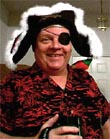|
|
This topic comprises 2 pages: 1 2
|
|
Author
|
Topic: Parallax error in changeover setups
|
|
|
Randy Stankey
Film God

Posts: 6539
From: Erie, Pennsylvania
Registered: Jun 99
|
 posted 04-19-2001 02:37 AM
posted 04-19-2001 02:37 AM




NEC (National Electrical Code) says that there is to be a minimum of 36 inches of free space on all sides of a projector, with the following exceptions:1) Of course the front of the projector doesn't need to be 3 feet from the wall becasuse the only thing there is the lens and you need to keep the distance from the proj. to the port window to a minimum. 2) In a 2 machine set up, the 36 inches counts "concurrently" between the two. ie: You can have them 3 feet apart instead of 6 feet. They also have to be installed in their own "permanent" enclosure which separates them completely from the audience. There has to be glass in the port window too. (I think there's an exception for the glass if the port is less than 12 inches square, but I'm not sure on that one.) I don't know if that makes sense to you but that's what the code says. I don't think it necessarily applies to projectors set up in the home, excepting that all the other usual electrical codes need to be met. A lot of the NEC for projectors seems to be throw-backs to the nitrate days. If it were me, I'd have the projectors close enough together so I could reach both machines from the middle without having to take more than a step or two... Just enough room to manuver comfortably.
| IP: Logged
|
|
Paul G. Thompson
The Weenie Man

Posts: 4718
From: Mount Vernon WA USA
Registered: Nov 2000
|
 posted 04-19-2001 03:08 AM
posted 04-19-2001 03:08 AM




Josh, what Randy says is a good guide. At the station theater at NAS Whidbey Island, the distance between the projector lense was about 5 feet or so, maybe a little less. At changeover, if done correctly, the only thing the audience might have noticed was a color temperature difference because the arc target drifted a little while I was waiting for the cue marks. Sometimes, the carbon arc lamps had a spasm that could not be corrected until after the change-over. Once you position yourself for a change-over in a carbon arc house, you stayed in that position. You did not reach around and scratch your butt, look at your target image, or whatever. You just stayed there until either the itch went away by itself, or the motor cues came by. I had hand operated sound change-overs, and foot operated picture changeovers in that booth. (A complete Brenkert booth.) You just concentrated on the upper right hand corner of the screen hoping the itch would go away.....  (now that should bring back some fond memories of you old carbon arc'ers) And, if it was a major itch, it might be time for the annual flea-dip, or time to visit your "friendly" neighborhood Proctologist...  OK - I got carried away....but I think the angle offset of the projectors was 3 degrees maximum each, or maybe 6 degrees. Can someone verify the correct parameters on that? It has been a long time.... It was a 986 seat auditorium, with a 105 foot 4 inch throw.
| IP: Logged
|
|
|
|
John Pytlak
Film God

Posts: 9987
From: Rochester, NY 14650-1922
Registered: Jan 2000
|
 posted 04-19-2001 11:03 AM
posted 04-19-2001 11:03 AM





The closer together that optical axis are, the better. But do leave enough room to comfortably service the machines, and stay within code. Of course, the ideal is perfectly perpendicular to the screen center. In practice, try to keep the angle to less than a few degrees to minimize keystone distortion.Some have tried using mirrors to keep the beams of two projectors on centerline (e.g.,"Ultra-Vision"), but IMHO, this is overkill, and brings in a whole new set of concerns.
------------------
John P. Pytlak, Senior Technical Specialist
Worldwide Technical Services, Entertainment Imaging
Eastman Kodak Company
Research Labs, Building 69, Room 7419
Rochester, New York, 14650-1922 USA
Tel: 716-477-5325 Cell: 716-781-4036 Fax: 716-722-7243
E-Mail: john.pytlak@kodak.com
Web site: http://www.kodak.com/go/motion
| IP: Logged
|
|
|
|
Scott Norwood
Film God

Posts: 8146
From: Boston, MA. USA (1774.21 miles northeast of Dallas)
Registered: Jun 99
|
 posted 04-19-2001 01:35 PM
posted 04-19-2001 01:35 PM





This is an interesting thread. The "old" SMPTE projectionist book has booth plans that suggest something like 6 feet between lens axes, although I don't remember exactly and don't have the book handy. They also suggest wide portholes, although most booths that I've seen have standard 12" square ports. Maybe someone can look this up and post it. Some states may have codes for this, too...I vaguely remember that the Massachusetts projectionist license exam had a question about this on it.
I would think that in most cases, the side-to-side keystone issue would be far less than the issues related to extreme tilt angles, since precious few theatres have a completely straight-on path from lens to screen. There's also the issue of xenon setups where theatres don't replace the lamps at the same time, so the picture becomes more or less blue every 20 minutes, which is not a pretty sight, even with long throws. On the other hand, vertical keystone is less objectionable to most people (me included), probably because most of us are just used to seeing it and can mentally correct for it.
I have noticed definite keystone issues in theatres that put the 35mm machines equally off center in opposite directions and then put a 16mm projector to the side of one of the 35mm machines. The 16mm image tends to look obviously keystoned. Oddly, I've also seen some theatres that put the 16mm machine _between_ the 35mm projectors; it seems like this wouldn't be a very desirable booth configuration, though.
| IP: Logged
|
|
|
|
Steve Guttag
We forgot the crackers Gromit!!!

Posts: 12814
From: Annapolis, MD
Registered: Dec 1999
|
 posted 04-19-2001 10:48 PM
posted 04-19-2001 10:48 PM




Paul is on the money on this one. Though I don't think parallax is the proper term for this one. Generally parallax referrs to someone mis-judging a 3 dimentional object due to the spacing between the various levels (I'm sure someone will produce the dictionary definition). The most common situation for techies is when viewing an analog meter (like the ammeter on a lamphouse)..depending on the angle of sight, one might misread the meter. Better meters use a mirrored scale so parallax distortion is eliminated.What I think you mean is Keystone distortion. Perspective change adapters or the eccentrics used in some projectors (eg Century SA) can be used to reduce or eliminate this sort of distortion. Steve ------------------
"Old projectionists never die, they just changeover!"
| IP: Logged
|
|
Phil Hill
I love my cootie bug

Posts: 7595
From: Hollywood, CA USA
Registered: Mar 2000
|
 posted 04-19-2001 11:24 PM
posted 04-19-2001 11:24 PM



Although some keystone can be corrected by offsetting the lens in either the horizontial or vertical, doing it will introduce linearity distortion in the image. The greater the offset, the greater the linearity distortion. A real problem in dual projector 3D presentations.A correctly designed theatre would minimize the off-center projection angle (down and horizontal angles), the lens offset (a large pupil lens to minimize vignetting), and the screen tilt. >>> Phil
| IP: Logged
|
|
|
|
|
|
Paul G. Thompson
The Weenie Man

Posts: 4718
From: Mount Vernon WA USA
Registered: Nov 2000
|
 posted 04-21-2001 01:55 AM
posted 04-21-2001 01:55 AM




This might sound a little silly and wild, but there was a theater in Oakland, California that had the projection booth underneath the stage. There was basically a hole in the floor, and two rather large mirrors at about 45 degrees each (take or leave a few degrees) were used to get the picture out of the basement and on to the screen. The booth had Cinemachannica (sp) V-4 machines. I was surprised how nice the picture actually was....Seems to me that the very short-throw large-screen houses with the booth up in God's country could use this technique to fool the system so the screen has a more of a head-on shot. It might be worth it just to reduce the obnoxious keystoning. I am sure the mirrors would be a bitch to clean, but if it works without too many problems, maybe it could be an answer, especially if the mirrors are made from optical glass. Another wild thought - maybe a set of mirrors for each projector in a 2 projector operation might be practical in reducing side keystoning? A bigger xenon bulb might be needed to allow for losses, but what the heck? If it works, it works! Has anyone actually tried this? What were the results? Or, am I just dreaming? I'll almost bet some engineer who specialized in optics could throw in Finnigan's Finagling Factor and make it practical.
| IP: Logged
|
|
Phil Hill
I love my cootie bug

Posts: 7595
From: Hollywood, CA USA
Registered: Mar 2000
|
 posted 04-21-2001 03:20 AM
posted 04-21-2001 03:20 AM



Randy:
Actually my 3D systems (35mm & 5/70mm & 8/70mm) use a "normal" right-hand projector coupled (mechanically or electronically) to a left-hand (mirror image) projector to form one machine with 2 independent (7kW or 15kW) lamphouses. My 15/70 designs use a moveable projector scheme that provides about a 60 inch inter-occular.The big plus is that the inter-occular distance in only about 30 inches compared to the normal 60-72 inches. The result is a fantastic 3D image with minimal horizontal keystone distortion especially in short-throw theatres.
>>> Phil
| IP: Logged
|
|
|
|
|
|
All times are Central (GMT -6:00)
|
This topic comprises 2 pages: 1 2
|
Powered by Infopop Corporation
UBB.classicTM
6.3.1.2
The Film-Tech Forums are designed for various members related to the cinema industry to express their opinions, viewpoints and testimonials on various products, services and events based upon speculation, personal knowledge and factual information through use, therefore all views represented here allow no liability upon the publishers of this web site and the owners of said views assume no liability for any ill will resulting from these postings. The posts made here are for educational as well as entertainment purposes and as such anyone viewing this portion of the website must accept these views as statements of the author of that opinion
and agrees to release the authors from any and all liability.
|

 Home
Home
 Products
Products
 Store
Store
 Forum
Forum
 Warehouse
Warehouse
 Contact Us
Contact Us




 Printer-friendly view of this topic
Printer-friendly view of this topic


















